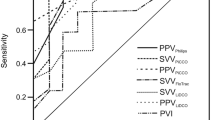Abstract
Background and objective
Stroke volume variation (SVV) has high sensitivity and specificity in predicting fluid responsiveness. However, sinus rhythm (SR) and controlled mechanical ventilation (CV) are mandatory for their application. Several studies suggest a limited applicability of SVV in intensive care unit (ICU) patients. We hypothesized that the applicability of SVV might be different over time and within certain subgroups of ICU patients. Therefore, we analysed the prevalence of SR and CV in ICU patients during the first 24 h of PiCCO-monitoring (primary endpoint) and during the total ICU stay. We also investigated the applicability of SVV in the subgroups of patients with sepsis, cirrhosis, and acute pancreatitis.
Methods
The prevalence of SR and CV was documented immediately before 1241 thermodilution measurements in 88 patients. Results: In all measurements, SVV was applicable in about 24%. However, the applicability of SVV was time-dependent: the prevalence of both SR and CV was higher during the first 24 h compared to measurements thereafter (36.1% vs. 21.9%; P<0.001). Within different subgroups, the applicability during the first 24 h of monitoring ranged between 0% in acute pancreatitis, 25.5% in liver failure, and 48.9% in patients without pancreatitis, liver failure, pneumonia or sepsis.
Conclusions
The applicability of SVV in a predominantly medical ICU is only about 25%–35%. The prevalence of both mandatory criteria decreases over time during the ICU stay. Furthermore, the applicability is particularly low in patients with acute pancreatitis and liver failure.
中文概要
目的
通过对危重病人在入院后24 小时内和整个重症 监护过程中窦性心律和控制呼吸情况的调查,分 析每搏量变异在评估危重病人容量反应的适用 性,并探究每搏量变异度在败血症、肝硬化和胰 腺炎病人中的适用性。
创新点
通过探究窦性节律和控制呼吸情况评估每搏量变 异度在重症监护病人临床上的适用性,弥补重症 监护病人窦性节律和控制呼吸情况数据的空白。
方法
在进行1241 次热稀释法血流量测量前,对88 位 病人的窦性节律和控制呼吸情况进行调查。
结论
每搏量变异度在主要的医疗重症监护病房中的适 用性只约为25%~35%。两项强制性指标的流行 性在重症监护病房的情况随时间的延长而降低。 此外,每搏量变异度在胰腺炎和肝功能衰竭患者 中的适用性尤其低。
Similar content being viewed by others
References
Al-Chalabi A, Matevossian E, v Thaden AK, et al., 2013. Evaluation of the Hepa Wash® treatment in pigs with acute liver failure. BMC Gastroenterol, 13:83. https://doi.org/10.1186/1471-230X-13-83
Benes J, Giglio M, Brienza N, et al., 2014a. The effects of goal-directed fluid therapy based on dynamic parameters on post-surgical outcome: a meta-analysis of randomized controlled trials. Crit Care, 18(5):584. https://doi.org/10.1186/s13054-014-0584-z
Benes J, Zatloukal J, Kletecka J, et al., 2014b. Respiratory induced dynamic variations of stroke volume and its surrogates as predictors of fluid responsiveness: applicability in the early stages of specific critical states. J Clin Monit Comput, 28(3):225–231. https://doi.org/10.1007/s10877-013-9524-8
Biais M, Ehrmann S, Mari A, et al., 2014. Clinical relevance of pulse pressure variations for predicting fluid responsiveness in mechanically ventilated intensive care unit patients: the grey zone approach. Crit Care, 18(6):587. https://doi.org/10.1186/s13054-014-0587-9
Cannesson M, Vallet B, Michard F, 2009. Pulse pressure variation and stroke volume variation: from flying blind to flying right? Br J Anaesth, 103(6):896–899. https://doi.org/10.1093/bja/aep321
Cannesson M, le Manach Y, Hofer CK, et al., 2011. Assessing the diagnostic accuracy of pulse pressure variations for the prediction of fluid responsiveness: a “gray zone” approach. Anesthesiology, 115(2):231–241. https://doi.org/10.1097/ALN.0b013e318225b80a
de Backer D, Taccone FS, Holsten R, et al., 2009. Influence of respiratory rate on stroke volume variation in mechanically ventilated patients. Anesthesiology, 110(5):1092–1097. https://doi.org/10.1097/ALN.0b013e31819db2a1
de Waal EE, Rex S, Kruitwagen CL, et al., 2009. Dynamic preload indicators fail to predict fluid responsiveness in open-chest conditions. Crit Care Med, 37(2):510–515. https://doi.org/10.1097/CCM.0b013e3181958bf7
Duperret S, Lhuillier F, Piriou V, et al., 2007. Increased intraabdominal pressure affects respiratory variations in arterial pressure in normovolaemic and hypovolaemic mechanically ventilated healthy pigs. Intensive Care Med, 33(1):163–171. https://doi.org/10.1007/s00134-006-0412-2
Goepfert MS, Richter HP, zu Eulenburg C, et al., 2013. Individually optimized hemodynamic therapy reduces complications and length of stay in the intensive care unit: a prospective, randomized controlled trial. Anesthesiology, 119(4):824–836. https://doi.org/10.1097/ALN.0b013e31829bd770
Hofkens PJ, Verrijcken A, Merveille K, et al., 2015. Common pitfalls and tips and tricks to get the most out of your transpulmonary thermodilution device: results of a survey and state-of-the-art review. Anaesthesiol Intensive Ther, 47(2):89–116. https://doi.org/10.5603/AIT.a2014.0068
Huber W, Umgelter A, Reindl W, et al., 2008. Volume assessment in patients with necrotizing pancreatitis: a comparison of intrathoracic blood volume index, central venous pressure, and hematocrit, and their correlation to cardiac index and extravascular lung water index. Crit Care Med, 36(8):2348–2354. https://doi.org/10.1097/CCM.0b013e3181809928
Huber W, Höllthaler J, Schuster T, et al., 2014. Association between different indexations of extravascular lung water (EVLW) and PaO2/FiO2: a two-center study in 231 patients. PLoS ONE, 9(8):e103854. https://doi.org/10.1371/journal.pone.0103854
Huber W, Kemnitz V, Phillip V, et al., 2015. Outcome prediction, fluid resuscitation, pain management, and antibiotic prophylaxis in severe acute pancreatitis. Intensive Care Med, 41(11):2034–2035. https://doi.org/10.1007/s00134-015-4022-8
Huber W, Phillip V, Höllthaler J, et al., 2016a. Femoral indicator injection for transpulmonary thermodilution using the EV1000/VolumeView®: do the same criteria apply as for the PiCCO®? J Zhejiang Univ-Sci B (Biomed & Biotechnol), 17(7):561–567. https://doi.org/10.1631/jzus.B1500244
Huber W, Fuchs S, Minning A, et al., 2016b. Transpulmonary thermodilution (TPTD) before, during and after sustained low efficiency dialysis (SLED). A prospective study on feasibility of TPTD and prediction of successful fluid removal. PLoS ONE, 11(4):e0153430. https://doi.org/10.1371/journal.pone.0153430
Huber W, Henschel B, Schmid R, et al., 2017. First clinical experience in 14 patients treated with ADVOS: a study on feasibility, safety and efficacy of a new type of albumin dialysis. BMC Gastroenterol, 17(1):32. https://doi.org/10.1186/s12876-017-0569-x
Lakhal K, Ehrmann S, Benzekri-Lefèvre D, et al., 2011. Respiratory pulse pressure variation fails to predict fluid responsiveness in acute respiratory distress syndrome. Crit Care, 15(2):R85. https://doi.org/10.1186/cc10083
Maguire S, Rinehart J, Vakharia S, et al., 2011. Respiratory variation in pulse pressure and plethysmographic waveforms: intraoperative applicability in a North American academic center. Anesth Analg, 112(1):94–96. https://doi.org/10.1213/ANE.0b013e318200366b
Mahjoub Y, Lejeune V, Muller L, et al., 2014. Evaluation of pulse pressure variation validity criteria in critically ill patients: a prospective observational multicentre pointprevalence study. Br J Anaesth, 112(4):681–685. https://doi.org/10.1093/bja/aet442
Mair S, Tschirdewahn J, Götz S, et al., 2016. Applicability of stroke volume variation in patients of a general intensive care unit: a longitudinal observational study. J Clin Monit Comput, 31(6):1177–1187. https://doi.org/10.1007/s10877-016-9951-4
Michard F, 2005. Volume management using dynamic parameters: the good, the bad, and the ugly. Chest, 128(4): 1902–1903. https://doi.org/10.1378/chest.128.4.1902
Michard F, Lopes MR, Auler JO Jr, 2007. Pulse pressure variation: beyond the fluid management of patients with shock. Crit Care, 11(3):131. https://doi.org/10.1186/cc5905
Monnet X, Bleibtreu A, Ferré A, et al., 2012. Passive leg-raising and end-expiratory occlusion tests perform better than pulse pressure variation in patients with low respiratory system compliance. Crit Care Med, 40(1): 152–157. https://doi.org/10.1097/CCM.0b013e31822f08d7
Moreau R, Jalan R, Gines P, et al., 2013. Acute-on-chronic liver failure is a distinct syndrome that develops in patients with acute decompensation of cirrhosis. Gastroenterology, 144(7):1426–1437. https://doi.org/10.1053/j.gastro.2013.02.042
Muller L, Louart G, Bousquet PJ, et al., 2010. The influence of the airway driving pressure on pulsed pressure variation as a predictor of fluid responsiveness. Intensive Care Med, 36(3):496–503. https://doi.org/10.1007/s00134-009-1686-y
Perel A, 1998. Assessing fluid responsiveness by the systolic pressure variation in mechanically ventilated patients. Systolic pressure variation as a guide to fluid therapy in patients with sepsis-induced hypotension. Anesthesiology, 89(6):1309–1310. https://doi.org/10.1097/00000542-199812000-00005
Phillip V, Saugel B, Ernesti C, et al., 2014. Effects of paracentesis on hemodynamic parameters and respiratory function in critically ill patients. BMC Gastroenterol, 14(1):18. https://doi.org/10.1186/1471-230X-14-18
Preisman S, Kogan S, Berkenstadt H, et al., 2005. Predicting fluid responsiveness in patients undergoing cardiac surgery: functional haemodynamic parameters including the respiratory systolic variation test and static preload indicators. Br J Anaesth, 95(6):746–755. https://doi.org/10.1093/bja/aei262
Renner J, Gruenewald M, Quaden R, et al., 2009. Influence of increased intra-abdominal pressure on fluid responsiveness predicted by pulse pressure variation and stroke volume variation in a porcine model. Crit Care Med, 37(2):650–658. https://doi.org/10.1097/CCM.0b013e3181959864
Reuter DA, Felbinger TW, Schmidt C, et al., 2002. Stroke volume variations for assessment of cardiac responsiveness to volume loading in mechanically ventilated patients after cardiac surgery. Intensive Care Med, 28(4): 392–398. https://doi.org/10.1007/s00134-002-1211-z
Reuter DA, Goepfert MS, Goresch T, et al., 2005. Assessing fluid responsiveness during open chest conditions. Br J Anaesth, 94(3):318–323. https://doi.org/10.1093/bja/aei043
Rhodes A, Evans LE, Alhazzani W, et al., 2017. Surviving sepsis campaign: international guidelines for management of sepsis and septic shock: 2016. Intensive Care Med, 43(3):304–377. https://doi.org/10.1007/s00134-017-4683-6
Sakka SG, 2015. Hemodynamic monitoring in the critically ill patient—current status and perspective. Front Med (Lausanne), 2:44. https://doi.org/10.3389/fmed.2015.00044
Saugel B, Phillip V, Gaa J, et al., 2012. Advanced hemodynamic monitoring before and after transjugular intrahepatic portosystemic shunt: implications for selection of patients—a prospective study. Radiology, 262(1):343–352. https://doi.org/10.1148/radiol.11110043
Sun Y, Lu ZH, Zhang XS, et al., 2015. The effects of fluid resuscitation according to picco on the early stage of severe acute pancreatitis. Pancreatology, 15(5):497–502. https://doi.org/10.1016/j.pan.2015.06.006
Trepte CJ, Bachmann KA, Stork JH, et al., 2013. The impact of early goal-directed fluid management on survival in an experimental model of severe acute pancreatitis. Intensive Care Med, 39(4):717–726. https://doi.org/10.1007/s00134-012-2775-x
Umgelter A, Schmid RM, 2009. Terlipressin for hepatorenal syndrome—what is the role of plasma expansion and hemodynamic monitoring? Z Gastroenterol, 47(3):307–308 (in German). https://doi.org/10.1055/s-0028-1109113
Umgelter A, Reindl W, Wagner KS, et al., 2008. Effects of plasma expansion with albumin and paracentesis on haemodynamics and kidney function in critically ill cirrhotic patients with tense ascites and hepatorenal syndrome: a prospective uncontrolled trial. Crit Care, 12(1): R4. https://doi.org/10.1186/cc6765
Umgelter A, Reindl W, Miedaner M, et al., 2009. Failure of current antibiotic first-line regimens and mortality in hospitalized patients with spontaneous bacterial peritonitis. Infection, 37(1):2–8. https://doi.org/10.1007/s15010-008-8060-9
Villar J, Pérez-Méndez L, Kacmarek RM, 2016. The berlin definition met our needs: no. Intensive Care Med, 42(5): 648–650. https://doi.org/10.1007/s00134-016-4242-6
Wendon J, Bernal W, Willars C, et al., 2011. Critical care and cirrhosis: outcome and benefit. Curr Opin Crit Care, 17(5):533–537. https://doi.org/10.1097/MCC.0b013e32834ab06f
Yu WQ, Zhang Y, Zhang SY, et al., 2016. Impact of misplaced subclavian vein catheter into jugular vein on transpulmonary thermodilution measurement variables. J Zhejiang Univ-Sci B (Biomed & Biotechnol), 17(1):60–66. https://doi.org/10.1631/jzus.B1500167
Zhang Z, Lu B, Sheng X, et al., 2011. Accuracy of stroke volume variation in predicting fluid responsiveness: a systematic review and meta-analysis. J Anesth, 25(6): 904–916. https://doi.org/10.1007/s00540-011-1217-1
Zhang Z, Lu B, Ni H, 2012. Prognostic value of extravascular lung water index in critically ill patients: a systematic review of the literature. J Crit Care, 27(4):420.e1-420.e8. https://doi.org/10.1016/j.jcrc.2011.09.006
Author information
Authors and Affiliations
Corresponding author
Rights and permissions
About this article
Cite this article
Huber, W., Mayr, U., Umgelter, A. et al. Mandatory criteria for the application of variability-based parameters of fluid responsiveness: a prospective study in different groups of ICU patients. J. Zhejiang Univ. Sci. B 19, 515–524 (2018). https://doi.org/10.1631/jzus.B1700243
Received:
Revised:
Accepted:
Published:
Issue Date:
DOI: https://doi.org/10.1631/jzus.B1700243




